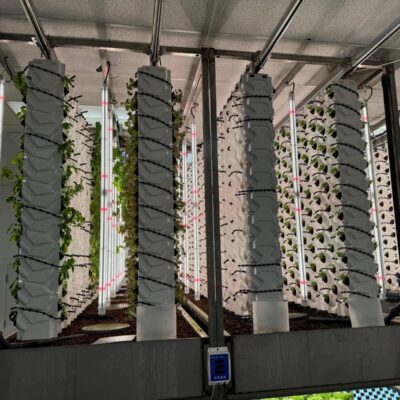 Do you wish to grow your own fresh fruits and vegetables while saving water and without chemical fertilizers? Aquaponics offers a green alternative that combines aquaculture (fish culture) with hydroponics (water-based plant culture) in a symbiotic system.
Do you wish to grow your own fresh fruits and vegetables while saving water and without chemical fertilizers? Aquaponics offers a green alternative that combines aquaculture (fish culture) with hydroponics (water-based plant culture) in a symbiotic system.
Whether you wish to grow for your family or start a business, we’ll walk you through the fundamentals of how to start with aquaponics on any scale.
Understanding the Aquaponic Ecosystem
At its core, aquaponics is about creating a natural cycle between fish and plants:
- Fish produce waste that contains ammonia
- Beneficial bacteria convert ammonia to nitrites, then to nitrates
- Plants absorb these nitrates as nutrients for growth
- Filtered water returns to the fish tank, completing the cycle
This elegant system mimics natural ecosystems while producing both protein (fish) and plants with minimal inputs and waste. Before diving into system setup, it’s essential to understand this nitrogen cycle, as it forms the foundation of successful aquaponic farming.
Choosing Your System Scale
Home and Hobby Systems
For beginners, starting small allows you to learn the basics with minimal investment. Home-scale systems typically include:
- Countertop systems: Perfect for apartments or small spaces, these compact units can grow herbs and small leafy greens with just a few small fish.
- Backyard systems: Utilizing IBC totes, barrels, or purpose-built kits, these setups can produce significant food for a family while fitting into a typical backyard space.
- Greenhouse integrations: Adding aquaponics to an existing greenhouse combines the benefits of both approaches for extended growing seasons.
Home systems typically range from 50-500 gallons of water and can produce 5-20 pounds of fish annually, along with continuous vegetable harvests.
Small Commercial Operations
Mid-sized operations bridge the gap between hobby and full commercial scale:
- Modified shipping containers: Solutions like our Farmtainer provide turnkey systems in controlled environments, producing up to 5,670 heads of lettuce monthly and 3,600 pounds of fish annually.
- Small greenhouse setups: Purpose-built greenhouses with integrated aquaponic systems ranging from 1,000-5,000 gallons can supply restaurants or small CSA programs.
These operations are ideal for urban farmers, schools, restaurants seeking ultra-fresh produce, and entrepreneurs testing the market before scaling further.
Full Commercial Operations
Large-scale aquaponic farms require significant investment but offer proportional returns:
- Multi-unit systems: Configurations like our Farmplex combine multiple growing units with centralized fish tanks and workspaces for optimized labor efficiency.
- Warehouse installations: Converting industrial spaces into controlled environment agriculture hubs can create year-round production in any climate.
- Acre+ greenhouse operations: Extensive greenhouse systems can produce hundreds of thousands of plants and thousands of pounds of fish annually.
Commercial systems typically employ automation, sophisticated monitoring, and dedicated staff to maximize production efficiency and consistency.
 Essential Components for Any Scale
Essential Components for Any Scale
Regardless of size, all aquaponic systems share fundamental components:
Fish Tanks
The fish component provides nutrients for your plants while also producing a protein harvest. Key considerations include:
- Volume: Larger water volume means more stability and forgiveness for beginners
- Shape: Round or curved-corner tanks prevent “dead zones” where waste accumulates
- Accessibility: Ensure you can easily feed fish and remove any mortalities
- Coverage: Tanks should be covered to prevent fish jumps and reduce algae growth
Growing Beds and Methods
Several approaches work well for the plant component:
- Media beds: Filled with expanded clay pebbles, gravel, or other inert media, these simplest systems work well for beginners and can grow a wide variety of crops.
- Deep water culture (DWC): Plants grow in floating rafts with roots suspended in nutrient-rich water, ideal for commercial lettuce and herb production.
- Nutrient film technique (NFT): Shallow channels carry a thin film of water past plant roots, excellent for leafy greens and herbs in space-efficient configurations.
- Vertical towers: Space-saving columns with plant ports maximize growing area in limited footprints.
Pumps and Plumbing
The circulatory system of your aquaponics setup includes:
- Water pumps: Size according to your total volume, aiming to circulate the entire system volume at least once per hour
- Air pumps and stones: Provide critical dissolved oxygen for fish, plants, and beneficial bacteria
- Piping: PVC is standard, sized appropriately for desired flow rates
- Valves: Allow for flow control and system maintenance
Monitoring Equipment
Success depends on maintaining proper water parameters:
- Essential tests: pH, ammonia, nitrite, nitrate, and temperature should be monitored regularly
- Dissolved oxygen meter: Critical for larger systems
- Automated monitoring: More advanced systems may incorporate digital sensors and alerts
Selecting Fish Species
Choose fish species based on your climate, system design, and goals:
For Beginners
- Tilapia: Fast-growing, disease-resistant, and tolerant of fluctuating conditions
- Goldfish/Koi: For ornamental systems where fish harvest isn’t the goal
- Catfish: Adaptable to various conditions and excellent for southern climates
For Advanced Systems
- Trout: Thrive in cooler water and command premium market prices
- Perch: Moderate growth rate with excellent flavor
- Bass: Popular game fish that adapts well to aquaponic conditions
Consider local regulations before selecting species, as some require permits or may be prohibited in certain areas.
Choosing Plants for Success
Not all plants perform equally in aquaponic systems:
Excellent Performers
- Leafy greens: Lettuce, kale, spinach, Swiss chard
- Herbs: Basil, mint, oregano, cilantro
- Fruiting plants: Tomatoes, peppers, cucumbers (with sufficient system maturity)
Challenging Crops
- Root vegetables: Possible but challenging in most systems
- Heavy feeders: Corn, squash, and melons may require supplementation
For commercial operations, focus on high-value, quick-turning crops with established markets.
System Startup and Cycling
The most critical phase in any aquaponic system is the initial cycling period:
- Assemble the system completely before adding fish or plants
- Add dechlorinated water and run pumps for 24-48 hours to check for leaks
- Introduce ammonia source: Either a small number of hardy fish or pure ammonia
- Monitor water parameters daily as beneficial bacteria establish
- Wait for nitrites to spike and then fall, followed by rising nitrate levels
- Begin adding plants once nitrates are detectable
- Gradually increase the fish stock as the system matures
This process typically takes 4-6 weeks and should not be rushed. Patience during cycling prevents fish loss and system crashes.
Daily Operations and Maintenance
Successful aquaponics requires consistent attention:
Daily Tasks
- Feed fish appropriately (1-2% of body weight for mature fish)
- Check water temperature and clarity
- Inspect for any system issues (leaks, clogged pipes)
- Remove any dead plant material
Weekly Tasks
- Test water parameters (pH, ammonia, nitrite, nitrate)
- Clean mechanical filters if present
- Harvest mature plants and restock growing areas
- Check and clean pump intakes
Monthly Tasks
- Deep clean filtration components
- Inspect and clean UV sterilizers if present
- Evaluate fish growth and health
- Review system performance and plan improvements
Common Challenges and Solutions
Even well-designed systems encounter obstacles:
Water Quality Issues
- High ammonia or nitrites: Reduce feeding, increase aeration, or consider partial water change in emergency situations
- pH fluctuations: Buffer with calcium carbonate or potassium bicarbonate; adjust gradually
- Temperature extremes: Insulate tanks, use heaters or chillers as needed for your species
Pest Management
- Prevention: Install physical barriers like insect netting
- Biological controls: Introduce beneficial insects like ladybugs
- Organic interventions: Consider neem oil or insecticidal soaps as last resorts, applying carefully to avoid water contamination
System Imbalances
- Too many fish: Reduce stocking density or increase plant growing area
- Too many plants: Add fish or supplement with organic nutrients
- Algae blooms: Reduce light exposure to water, ensure adequate plant coverage
Scaling Your Operation
As you gain experience, thoughtful expansion is possible:
From Home to Small Commercial
- Start with proven crops and systems before expanding
- Develop markets before increasing production
- Consider a Farmtainer as a turnkey solution for initial commercial scaling
From Small to Full Commercial
- Implement professional monitoring and automation
- Develop standard operating procedures for consistency
- Consider modularity (like our Farmplex system) for incremental growth
- Build in redundancy for critical systems
Economic Considerations
Understanding the business side is essential for commercial success:
Capital Costs
- Small hobby systems: $500-$2,000
- Home production systems: $2,000-$10,000
- Small commercial (Farmtainer scale): $30,000-$200,000
- Full commercial operations: $250,000+
Operating Costs
- Fish feed (largest recurring expense)
- Electricity for pumps and environmental controls
- Seeds and growing supplies
- Labor (increases with scale)
- Packaging and marketing (commercial operations)
Revenue Streams
- Premium produce sales to restaurants, grocers, or direct to consumers
- Fish sales (whole or processed)
- Value-added products like MicroRevive soil amendments
- Educational programs and system sales (for established operations)
Getting Support and Training
No one should go it alone in aquaponics:
- Courses and workshops: Many universities and extension offices offer training
- Online communities: Active forums provide peer support and troubleshooting
- Consultants: Professional guidance can prevent costly mistakes
- Turnkey solutions: Companies like Future Fresh Farms offer systems with training and ongoing support
Conclusion: Your Aquaponic Journey
Whether you’re interested in producing food for your family or building a business, aquaponics is an eco-friendly method to get fresh, healthy produce and fish. By starting at the appropriate scale, getting a grasp of the fundamental concepts, and consistent maintenance, you can be among the growing ranks of successful aquaponic farmers.
At Future Fresh Farms, we provide systems, training, and support to aquaponic farmers at every level from backyard hobbyists to commercial scale producers. Our Farmtainer and Farmplex systems offer proven solutions for those who are ready to grow beyond DIY techniques, or our experienced staff can guide you through the challenges of getting started and operating successful aquaponic businesses.
Ready to start your aquaponic journey? Contact us for a consultation, visit us at our farm in Provo, Utah, or browse our line of systems and products that make aquaponic farming simple, productive, and profitable at every level.



